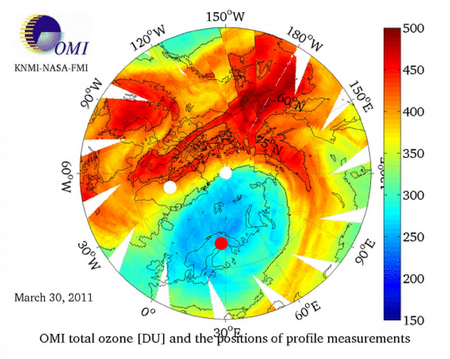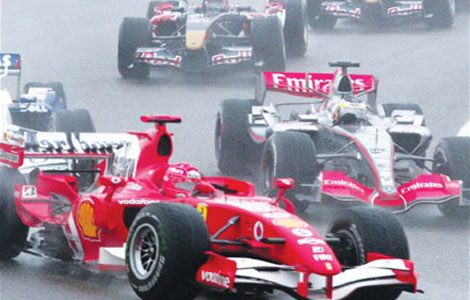Society
Ozone layer faces record 40 pct loss over Arctic
Updated: 2011-04-06 09:45
(Agencies)
|

An image of total ozone column profile around the North Pole on March 30, 2011 developed by Finnish Meteorological Institute using satellite and ground based data is seen in this April 5, 2011 handout. Record loss of the ozone, the atmosphere layer that shields life from the sun's harmful rays, has been observed over the Arctic in recent months, the World Meteorological Organization said on Tuesday. Satellite measurement of total ozone from OMI (Ozone Monitoring Instrument) shows a region of low ozone (blue region) above the Arctic regions. As of late March the ozone poor region is shifted away from the pole and covers Greenland and Scandinavia.[Photo/Agencies] |
GENEVA -- The protective ozone layer in the Arctic that keeps out the sun's most damaging rays -- ultraviolet radiation, has thinned about 40 percent this winter, a record drop, the UN weather agency said Tuesday.
The Arctic's damaged stratospheric ozone layer isn't the best known "ozone hole" that would be Antarctica's, which forms when sunlight returns in spring there each year. But the Arctic's situation is due to similar causes: ozone-munching compounds in air pollutants that are chemically triggered by a combination of extremely cold temperatures and sunlight.
The losses this winter in the Arctic's fragile ozone atmospheric layer strongly exceeded the previous seasonal loss of about 30 percent, the UN's World Meteorological Organization in Geneva said.
It blamed the combination of very cold temperatures in the stratosphere, the second major layer of the Earth's atmosphere, just above the troposphere, and ozone-eating CFCs from aerosol sprays and refrigeration.
"This is pretty sudden and unusual," said Bryan Johnson, an atmospheric chemist who works in the U.S. National Oceanic and Atmospheric Administration's Earth System Laboratory in Boulder, Colorado.
Atmospheric scientists concerned about global warming focus on the Arctic because that is a region where the effects are expected to be felt first.
"The Arctic stratosphere continues to be vulnerable to ozone destruction caused by ozone-depleting substances linked to human activities," the UN weather agency's secretary-general Michel Jarraud said.
Although the thinner ozone means more radiation can hit Earth's surface, the ozone levels in the Arctic remain higher than in other regions such as in the equatorial regions, said the National Oceanic and Atmospheric Administration, whose recent Arctic findings mirror those of the UN agency.
Ozone losses occur over the polar regions when temperatures drop below -78 degrees Celsius (-108 Fahrenheit) and iridescent ice clouds form. Sunlight on icy surfaces triggers the ozone-eating reactions in chlorine and bromine that comes from air pollutants such as chlorofluorocarbons, or CFCs, once widely used as refrigerants and flame retardants in household appliances.
| ||||
"Mostly the concern, for the Arctic ozone depletion, is for people that live in northern regions, more towards Iceland, northern Norway, the northern coast of Russia," he added, saying they should be more careful outside, wearing sunscreen and sunglasses.
As of late March, the UN said, the thinning ozone was shifting away from the pole and was covering Greenland and Scandinavia.
For the planet, Johnson said, there's the concern that "if this were to happen every year even though the ozone naturally regenerates itself,you might see a trending downward of the atmospheric ozone layer."
After scientists raised warnings in the early 1970s _ later earning a Nobel Prize _ virtually all the world's nations agreed to the 1987 treaty called the Montreal Protocol to cut back on CFCs used in air conditioning, aerosol sprays, foam packaging and other products.
But the compounds have long atmospheric lifetimes, so it takes decades for their concentrations to subside to the pre-1980 levels agreed to in the Montreal Protocol. The ozone layer outside the polar regions isn't expected to recover to pre-1980 levels until sometime between 2030 and 2040.
The ozone treaty also encourages industries to use replacement chemicals less damaging to ozone.
Some scientists say if that treaty hadn't been adopted, two-thirds of the world's protective ozone layer would be gone about a half-century from now and the CFCs, which also are long-lived potent greenhouse gases, would have pushed the world's temperature up an extra few degrees.
Arctic ozone conditions vary more than the seasonal ozone "hole" that forms high in the stratosphere near the South Pole each winter and spring, and the temperatures are always warmer in the Arctic than over Antarctica.
Because of the changing weather and temperatures that some Arctic winters experience, there have been times where there is almost no ozone loss, and others when the exceptionally cold stratospheric conditions has led to substantial ozone depletion, UN scientists say.
This year, the Arctic winter was warmer than average at ground level but colder in the stratosphere than normal. Average Arctic temperatures in January range from about -40 to 0 C (-40 to 32 F) and in July from about -10 to 10 C (14 to 50 F).
UN officials say the latest losses -- unprecedented but not entirely unexpected, were detected in satellite observations and weather balloons that show at what altitudes the ozone loss is occurring.
E-paper

Green light
F1 sponsors expect lucrative returns from Shanghai pit stop
Buying into the romance
Born to fly
Light of hope
Specials

Share your China stories!
Foreign readers are invited to share your China stories.

No more Mr. Bad Guy
Italian actor plans to smash ‘foreign devil’ myth and become the first white kungfu star made in China.

Art auctions
China accounted for 33% of global fine art sales.




